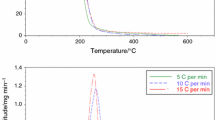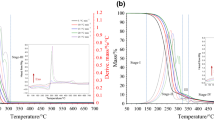Abstract
The combustion characteristics of bio-oils derived from rice husk and corn were studied by thermogravimetry analysis. According to the thermo-gravimetry (TG), differential thermogravimetry (DTG) and differential thermal analysis (DTA) curves of bio-oils in air and nitrogen atmosphere, we analyzed the combustion characteristics of different kinds of bio-oils in different atmospheres and worked out the combustion kinetics parameters of the bio-oil, providing reliable base data for the burning of bio-oil. The thermogravimetry indicated that the combustion process of bio-oil was divided into three stages. At the same time, the combustion process can be described by different order reaction models, and with the method of Coats-Redfern, the activation energy and frequency factor of different kinds of bio-oils were obtained.
Similar content being viewed by others
References
Wu C Z, Ma L L. Modern Utilization Technology of Biomass. Beijing: Journal of Chemistry and Industrial Press, 2003: 15–16
Lu Q, Zhu X F, Li Q X, Guo Q X, Zhu Q S. Biomass fast pyrolysis for liquid fuels. Progress Chemistry, 2007, 19(7): 1064–1071
Zhu X F, Lu Q, Guo Q X. Research on the characteristics of bio-oil combustion. Journal of University of Science and Technology of China, 2005, 35(6): 806–810
Ikura M, Stanciulescu M, Hogan E. Emulsification of pyrolysis derived bio-oil in diesel fuel. Biomass and Bio-energy. 2003, 24: 221–231
Shaddix C R, Hardesty D R. Combustion Properties of Biomass Flash Pyrolysis Oils. USA: Sandia National Laboratory, 1999: 1–71
OU DW, Fang L, Li G, Pan W, Chi Z H. Study on using condensed tertiary-air coal reburning reduction NOx technology. Power System Engineering, 2003(1): 24–26 (in Chinese)
Guo X Y, Yan Y J, Li T S, Ren Z W. Thermal stability and thermal decomposition of bio-oil before and after upgrading. Journal of East China University of Science and Technology, 2004, 30(3): 270–276 (in Chinese)
Cheng M Q, Wang J, Wang X Y, Zhang X C, Zhang S P, Ren Z W, Yan Y J. Composition of bio-oil prepared in a spout-fluidized bed reactor and its combustion characteristics. Journal of Anhui University of science and technology (Natural Science), 2005, 25(4): 69–73
Cai Z Q. Thermal Analysis. Beijing: Higher Education Press, 1993 (in Chinese)
A W Coats, J P Redfern. Kinetic parameters from thermogravimetric data. Nature, 1964, 201: 68–69
Hu R Z, Shi Q Z. Kinetics of thermal analysis. Beijing: Science Press, 2001 (in Chinese)
Zhang S P, Yan Y J.et al. Combustion characteristics and kinetics model of biomass pyrolysis oil. Journal of East China University of Science and Technology, 2002(2): 104–106 (in Chinese)
Author information
Authors and Affiliations
Corresponding author
Rights and permissions
About this article
Cite this article
Zhang, R., Zhong, Z. & Huang, Y. Combustion characteristics and kinetics of bio-oil. Front. Chem. Eng. China 3, 119–124 (2009). https://doi.org/10.1007/s11705-009-0068-x
Received:
Accepted:
Published:
Issue Date:
DOI: https://doi.org/10.1007/s11705-009-0068-x




